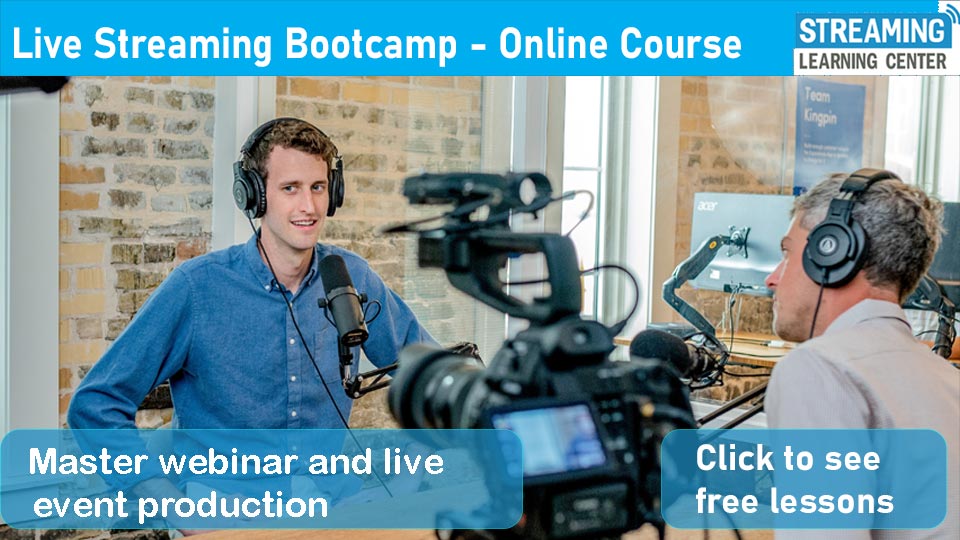Netflix started the per-title encode optimization revolution in December 2015, and now per-title encoding is showing up in more and more places. Why? Because it improves the quality of hard-to-encode videos, and saves bandwidth costs on easier-to-encode videos. If per-title optimization is not available in your encoder or encoding service, it’s time to start demanding it. OK, perhaps the title …
Read More »When it Comes to HTML5 Playback, the Devil’s in the Details
The promise of a unifying standard to simplify our lives is attractive, but putting it into practice is another thing. Here’s how one HTML5 video project got messy in a hurry. As much as we expect standards like HTML5 to simplify our jobs, oftentimes they don’t. In fact, a recent HTML5-related project convinced me that the term “multivendor standard” is …
Read More »How to Build Your Encoding Ladder, Bitrates and Resolution
Stephen Nathans-Kelly, a video producer at Streaming Media Magazine, is carving conference videos into short useful segments. Here are the first two videos on building your encoding ladder from my talk on how to use objective quality metrics you can watch in its entirety here, as well as download the handout. The first video covers the bitrate side, the second …
Read More »The Decline of the Standards-Based Codec—and Good Riddance
Online is different from broadcast and doesn’t need formal standards. HEVC isn’t considered by many online video streamers, as the future belongs to VP9 and AV1. Elsewhere in the issue, you find a 4,000-word article I wrote on VP9 that doesn’t mention HEVC. Why? Because for the vast majority of streaming producers that don’t distribute 4K video to smart TVs, …
Read More »Netflix Discusses VP9-Related Development Efforts
Once counted out, VP9 is on the rise, with support from Netflix, JW Player, Brightcove, and more. In this interview, David Ronca of Netflix talks about VP9 savings, encoding, and testing. This is an interesting time in the codec world, an inflection point where the power of an expensive standard is being challenged by a free, open source codec. And …
Read More »Book Excerpt: VBV Buffer Explained
This article is kind of a prequel to my book, Encoding by the Numbers, which I published in 2016. That is, I published this article to get commentary from folks who read it, which I factored back into my book. Unfortunately, I changed content management systems in 2018 and lost the comments. One of the topics I’m addressing in my …
Read More »The Cost of the Cloud for Video Encoding: Crunching the Numbers
Cloud encoding companies offer software-as-a-service and platform-as-a-service options. Here’s how to decide when to go with the cloud, and which option is right for your needs. ou need many different types of data—and lots of it—to make a good decision on cloud versus on-prem. I learned this recently while running a comparison for a consulting client with substantial encoding requirements. …
Read More »Encoding Brief: Apple Releases HLS Authoring Specification for Apple TV
Executive Summary: In October 2015, Apple released a document entitled HLS Authoring Specifications for Apple TV (HLS stands for HTTP Live Streaming, the adaptive bit rate technology used to deliver video to Apple TV and other iOS devices). If you’re producing for Apple TV, and aren’t aware of these specs, you should review them immediately. In a broader sense, Apple …
Read More »Netflix Admits to Throttling AT&T and Verizon Cellular Movies
Last week, Netflix admitted that they artificially throttle the data rate of videos transmitted over AT&T and Verizon cellular networks to limit bandwidth consumption and the associated overage charges. Netflix doesn’t throttle video streams transmitted on other cellular networks like T-Mobile and Sprint that don’t charge for overages. The story was broken by the Wall Street Journal, who raised issues …
Read More »Webinar: Simplifying Encoder Purchase and Configuration Decisions with Real Time Quality Metrics
I’m participating in a webinar with IneoQuest on Thursday, March 31 at 2:00 PM EST as part of their launch of a new product with live, non-referential quality metrics. The bottom line is that if you’re comparing real-time encoders to make a purchase decision, or configuring live encoders you already have, you can gauge the quality in real time, while …
Read More » Streaming Learning Center Where Streaming Professionals Learn to Excel
Streaming Learning Center Where Streaming Professionals Learn to Excel



